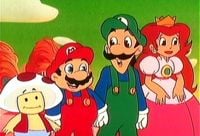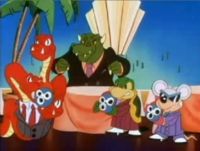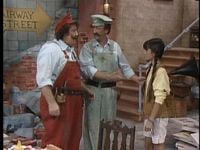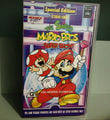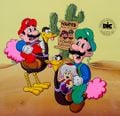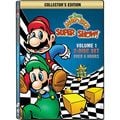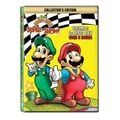The Super Mario Bros. Super Show!
Template:TV-infobox The Super Mario Bros. Super Show! was the first of the three series in DIC Entertainment's Super Mario animated cartoon trilogy, aired between September and December of 1989; it was the only one to be produced directly for syndication. The show featured live-action segments in which Mario and Luigi (played by Lou Albano and Danny Wells respectively), living in their basement workshop in Brooklyn, were often visited by various celebrity guest stars. Also featured were cartoons based on the first and second Super Mario Bros. games, where the Mario brothers teamed up with Princess Peach (then known as Princess Toadstool) and Toad to battle King Koopa and his forces to save the many lands of the world. The Super Mario Bros. cartoons were shown on Mondays through Thursdays only; on Fridays, the show would air cartoons based on the Legend of Zelda series. In 1990, a show called Club Mario appeared combining the animated segments with the live-action adventures of a boy named Tommy Treehugger.
Background
Each episode began with a live-action segment (all of which took place before the brothers discovered the Mushroom Kingdom) starring Mario (portrayed by World Wrestling Federation/Entertainment Hall of Famer, the late "Captain" Lou Albano) and Luigi (the late Danny Wells) living in Brooklyn, where they would often be visited by a celebrity guest star either playing themselves or another character at Mario Brothers Plumbing, a basement workshop which doubled as their home.
The live-action segment would be followed by a cartoon based on the Super Mario Bros. and Super Mario Bros. 2 video games, where Mario, Luigi, Princess Toadstool (Peach), and Toad would battle against King Koopa (Bowser) throughout the many lands of the world, often in a movie or historical parody. Mouser, Tryclyde, Fryguy and a single, unnamed Koopa Troopa often worked closely with King Koopa, serving as his henchmen. Getting into the spirit of these parodies, King Koopa usually took on a varying alter ego. He had a different outfit for each one, and would take on a different alias to along with it. For example, in a riverboat-themed episode, King Koopa was "Captain Koopa", while in one of the western-themed episodes, he went by "Billy the Koopa". In many episodes, King Koopa's minions would often dress up in outfits as well, to go along with Koopa's themed costumes. In some episodes, King Koopa would go without an alter ego nor wear a costume except for "Mario and the Beanstalk", "Jungle Fever" and "Mario of the Apes". The only episode where King Koopa doesn't appear is "Love 'Em and Leave 'Em".
Wart, the main antagonist of the second game, was never in any of the episodes, yet most of his minions managed to appear as members of the Koopa Pack. Like most 1980s cartoons, King Koopa would prolong the series' run by escaping from his adversaries (which he did through the use of Magic Potion), even though they could easily catch him.
The basis of the storyline (introduced at the beginning of every animated episode) was that Mario and Luigi were working on a bathtub drain which unknowingly was a warp zone to the Mushroom Kingdom, and Mario and Luigi had literally gone down the drain and ended up in the Mushroom Kingdom, by sheer coincidence causing problems for King Koopa and rescuing Toad and Princess Toadstool. Now that they were rescued, the focus for the Mario Brothers was to return to Brooklyn, while stopping King Koopa's tyranny whenever they could. Lou Albano and Danny Wells also voiced Mario and Luigi for the animated segment. It was never revealed whether their live action sequences were a prequel to the animated series or they successfully returned to Brooklyn and resumed their duties in the plumbing business.
Following the cartoon was the third portion of the episode, which continued the story that the live-action segment set up in the beginning. Towards the end, the second part of the live-action segment was interrupted with scenes from that week's upcoming episode of The Legend of Zelda.
The Super Mario Bros. cartoon was shown on Mondays through Thursdays only. On Fridays, the show would air The Legend of Zelda cartoons based on the game of the same name. However, a Mario live-action segment would air with the Zelda episodes.
On September 3, 1990, the show changed its name to Club Mario, replacing the live-action Mario segment with two completely different characters known as Tommy Treehugger and Co M.C., with occasional appearances by Tammy Treehugger (Tommy's twin sister) and Evil Eric (Co M.C.'s evil twin brother).
In another Mario related television series, King Koopa's Kool Kartoons, framed portraits of The Super Mario Bros. Super Show! versions of Mario, Luigi, Toad and Princess Toadstool can be seen in various episodes.
Broadcast history
The show lasted from 1989 to 1990.
After DiC's Mario cartoons ended, the show was aired in reruns on the Family Channel (currently known as Freeform). The Family Channel's reruns of the series removed the Legend of Zelda previews and the scenes that segued into them from the live-action segments, and slowed down the episodes to bring them back to their original length. They also changed the placement of the commercial breaks, placing them during scene dissolves in the animated segments. (Curiously, the Family Channel version of "King Mario of Cramalot" and "Day of the Orphan" is the version used in subsequent DVD and digital releases.) Also, from that point onward, the song covers played during the cartoon's chase scenes were removed and replaced them with instrumentals of songs featured in The Adventures of Super Mario Bros. 3 and Super Mario World. This was probably done for licensing reasons as the lyrics of the song covers are copyrighted.
From 1989 to 1991, Kid Klassics released NTSC VHS videos of the show. These videos contained two, one, or no live-action segments, and featured the cartoon segments with their original song covers intact. On these videos, the "Super Mario Bros." theme wasn't included before the cartoon segment.
The show was made available to watch from Yahooligans! TV starting in March 2004, with a new episode usually uploaded every week. It was taken down along with all DiC Entertainment cartoons on December 24, 2005.
As of November 3, 2009 it can be watched at Jaroo.com, a video-streaming website owned by Cookie Jar Group. The website routinely cycles through all fifty-two of the show's episodes, hosting five at any given time. Each Tuesday, the next episode in line is added, with the oldest being dropped. Since DHX Media purchased Cookie Jar, Jaroo was taken down.
As of 2011, it can be watched via Netflix and Hulu.
Main Protagonists
Main Antagonists
Cast
Regulars
- Lou Albano — Mario, Man 1, Flab Bro 1, Citizen 2, Citizen 3, Pidget 1, Guy 1 and Mushroom 5
- Danny Wells — Luigi, Salvador Drainado,
- Jeannie Elias — Princess Toadstool, Birdo, and Shy Guy
- John Stocker — Toad, Mouser, Koopa Troopa and Beezo
- Harvey Atkin — King Koopa, Tryclyde, Sergeant Kooperman, Snifit, Calamity Clam, Talking Head, Crocodile 1, Crocodile 2, Down Under Land Mayor, Goomba 3 and Hooded Robin
- Robert Bockstael — (Additional Voices)
- Dorian Joe Clark — (Additional Voices)
- Rob Cowan — (Additional Voices)
- Denise Pidgeon — (Additional Voices)
- Paulina Gillis — (Additional Voices)
- Greg Morton — (Additional Voices)
- Joyce Gordon — (Additional Voices)
- Greg Swanson — (Additional Voices)
- Diane Fabian — (Additional Voices)
- Marilyn Lightstone — (Additional Voices)
- Marla Lukofsky — (Additional Voices)
Live - Action Guest stars
- Nicole Eggert (herself)
- Danica McKellar (Patty)
- Karen Hartman (Patty's mother)
- Jim Ward (Patty's father and Count Zoltan Dracula)
- Sgt. Slaughter (himself)
- Joseph Griffo (mini Mario)
- Lyle Alzado (himself)
- Eugene Liebowitz (Dr. Frankenstein)
- Craig Armstrong (Frankenstein's Monster and Gorilla)
- Larry Gelman (Dr. Sigmund Fruitcake and Vincent Van Gook)
- Fred Travalena (Elvis Presley and Mr. Gibbel)
- Paul Elder (Alligator Dundee)
- Shabba-Doo (himself)
- Pam Matteson (Cher and herself)
- Clare Carey (E.C.)
- David Horowitz (himself)
- Harry Blackstone Jr. (himself)
- Magic Johnson (himself)
- Marty Allen (Imperial Poobah)
- Donna Douglas (Ellie Mae)
- Gary Schwartz (Dr. Toby, Inspector Klean and Doc Freud)
- Patrick Dempsey (Plant Monster)
- Regina Williams (Susanna Ross)
- Philop Clark (HAL 9001)
- Ed Metzger (Einstein)
- Vic Dunlop (Pietro)
- Nedra Volz (Angelica)
- Scott Nemes (Young McDonald)
- Rob Stone (himself)
- Kay Ballard (Madam AGoGo)
- Brian Bonsall (himself)
- Ed Metzger (George Washington, Ralph Washington)
- Sonny Trinidad (Obi-Wan Cannoli)
- Norman Fell (Ted Bull
- Andy Heyward (Howard Stevens)
- Jim Lange (himself)
- Gary Owens (The Wonderfully Wacky Willy White)
- Martin C. Gardner (Mikhail S. Gorbachev)
- Melanie Chartoff (Tawny Tyler)
- Vicki Bakken (Liz)
- Courtney Gibbs (Luigi's girlfriend)
- Joe Bellan (Tommy Lasagna)
- Karen Hartman (Mrs. Gammliss)
- Vanna White (Roxanne)
- Rowdy Roddy Piper (himself)
- Kort Falkenberg (Nick)
- Cyndi Lauper (herself)
- Ernie Hudson (himself)
- Moon Zappa (Marilyn)
- Elvira (herself)
- Norman Fell (Fred Van Winkle)
- Willard E. Pugh (Little Robert)
- Paula Irvine (Mad Donna)
- Maurice LaMarche (Inspector Gadget)
- Elaine Kagan (The Old Psychic Lady with the Evil Eye Who Reads Fortunes and Knows Everything Before it Happens)
- Eve Plumb (Jodie)
Episodes
| Monday | Tuesday | Wednesday | Thursday | Friday (The Legend of Zelda) |
|---|---|---|---|---|
Lyrics
Plumber Rap Part 1 (show intro)
We're the Mario Brothers, and plumbing's our game
We're not like the others who get all the fame
If your sink is in trouble, you can call us on the double
We're faster than the others, you'll be hooked on the Brothers- Unh!
H-hooked on the brothers
Gimme gimme, gimme gimme!
Yo, you're in for a treat, so hang on to your seat
Get ready for adventure and remarkable feats
You'll meet Koopa, the Troopas, the Princess, and the others
Hangin' with the plumbers, you'll be hooked on the brothers!
To the bridge!
Unh! Unh!
I say a h-h-h-h-hooked on the brothers!
The brothers!
The brothers!
Plumber Rap Part 2 (animated episodes intro)
It's the mario brothers and plumbin's their game
Found the secret warp zone while working on the drain
Lend the princess a hand in the mushroom land.
Join the action with the plumbers, you'll be hooked on the brothers!
Nooooooooow, evil Koopa and his Troopas are up to misbehavin'
They kidnapped the princess; Mushroom Land needs savin'
Abusin' and confusin', everybody discovers
They can't help but be hooked on the brothers! Unh!
Do the Mario (closing credits)
- Main article: Do the Mario
Home releases
VHSes:
- US (Pre-Paramount): Mario Meets Koopzilla, Koopa Klaus, Count Koopula, The Great BMX Race, The Great Gladiator Gig, Butch Mario And The Luigi Kid, Mario's Magic Carpet, Hooded Robin, Two Plumbers And A Baby, Super Christmas Adventures (Dic Video through Kids Klassics), and VHS's from Dic Video and Paramount when it was owned by Viacom.
- UK: Super Show (Pickwick Video), Great BMX Race/Pirates Of The Koopa, Special Extended Edition, Princess, I Shrunk The Marios. (Tempo Video/Pickwick Video), and VHS'S From Dic Video, CIC Video, and Paramount when Paramount was owned by Viacom
DVDs:
- Three one-disc sets by Sterling Productions.
- At least eight one-disc sets by NCircle Entertainment.
- Three one-disc sets by Maximum Entertainment (UK only).
- One one-disc set by Trimark.
- Two four-disc box-sets by Shout! Factory (released 2006).
- One two-disc set by Beyond Home Entertainment (Australia only).
- One six-disc set by Beyond Home Entertainment (Australia only).
Production
Strong from its multiple animated shows based on pre-existing properties, DIC Entertainment approached Nintendo with an offer to make a cartoon based on the Mario franchise. Nintendo initially declined, but later signed a deal after DIC put together a creative team they liked [1]. Nintendo required DIC to pay extensive royalties, an unusual arrangement for children programming at the time.
According to Danny Wells, him and co-star Lou Albano recorded the show on a six days schedule, where they would first film the live-action segments and then drive to another studio in order to record voices for the animated segments.
In an interview about DIC's history in adapting video games to television, DIC executive Robby London stated that video games such as Super Mario Bros. were DIC's favorite type of media to adapt because "[...] the videogames themselves were colourful, imaginative, hip and more than a little bizarre – in the best sense" and that their sparse lores and simple character allowed more creativity than when adapting material from other media[2]. London also spoke positively of Nintendo's involvement in the show, stating "[...] Nintendo was reasonable, professional and good to deal with. Their America office seemed quite capable of speaking definitively on behalf of their Japanese owners, and I don’t remember any problematic disputes with Nintendo [...]" and contrasting it with DIC's more turbulent partnership with Sega for its three Sonic series[2].
The series was a rating success and was widely syndicated[1]. Also, according to Wells, the guest stars actively asked to be part of the live-action segments due to the popularity of Super Mario Bros. with their children [1]. However, despite its success, Nintendo had little interest in continuing the show beyond the initial package, leading to its cancelation.
Staff
- Main article: List of The Super Mario Bros. Super Show! staff
The Super Show was executive produced by Andy Heyward, directed by Dan Riba and produced by John Grusd, who also produced and directed the two subsequent Mario cartoons by DIC. Animation was provided by Sei Young Animation Co., Ltd.. The live-action sequences were co-produced with Saban Productions.
Differences from the games
- Several characters have very different appearances from what became their standard character models in later years, mostly owing to being based on sprites and/or character artwork from Donkey Kong, Super Mario Bros. and Super Mario Bros. 2.
- King Koopa's appearance was loosely based on his sprite from Super Mario Bros. His main skin color is green instead of orange-yellow; his ribbed stomach is deeper yellow than its game color; he has a crocodilian snout that matches the rest of his skin in coloration; he has two spike-bands instead of five (worn on his wrists only), which are dark green with gold spikes, instead of black with white spikes; his shell has a bright green lining and fewer spikes than in the games; his horn- and spike-rings are green like his skin; he has a crown instead of a mane, and no eyebrows; his tongue is reptilian instead of human-like; and his eyes are yellow instead of white and lack their red irises.
- Princess Toadstool's model portrays her as a redhead instead of a blonde, resembling her sprites from the first two Super Mario Bros. games. She also lacks her gloves and crown jewels, and her brooch, earrings, and eye color are green rather than blue.
- Mario and Luigi have overalls matching their cap colors, with blue shirts, and also have black hair instead of brown, along the lines of their early appearances in sprites and artwork.
- Toad's appearance is based on his sprite from Super Mario Bros., with the waistcoat being red instead of blue. In the first three episodes, all instances of white and red in his appearance were inverted, but this was fixed from the fourth episode onwards, although his shoes were recolored purple instead of the red from the original sprite. However, Toad's original inverted color scheme was reused for his super form in the episode "The Fire of Hercufleas" and on VHS and DVD covers.
- In several episodes, Birdos were shown to fly, a trait not seen in any Mario game.
- Rather than becoming Fire Mario, unlike in the games, Mario (or Luigi) would become "Super Mario" or "Super Luigi" upon touching either a Fire Flower, Starman, or some other source of excessive power. As Super Mario, Mario could hurl fireballs, had super-strength, and on a few rare occasions, could even fly. Although Mario could lose his powers by taking a hit (similar to the 2D Mario side-scrollers), it was also possible for them to wear off after a while.
- Mario's super form is based on his fire form sprites from Super Mario Bros.; Luigi's variant of this form replaces the red with his defining color, green. This resembles what would be their standard fire form color schemes from Super Mario World onwards, but with their shirt and overall colors swapped.
- Although Mario's eyes are the established blue, Luigi's are green instead. However, their game color is used on the cover of the Volume 1 DVD set.
- Trouters were portrayed as being far more vicious than they were in Super Mario Bros. 2, and would pursue anybody who came near them. Their appearance more closely resembles that of Cheep-Cheeps, and they may be only a merger of the two enemies.
Differences from the other series
- The voices of Mario and Luigi in this show most resembles the voice of them heard today, whereas their voices in The Adventures of Super Mario Bros. 3 and Super Mario World shows (voiced by Walker Boone and Tony Rosato, respectively) was lower and raspier for Mario, and higher and raspier for Luigi, instead of Mario having a higher pitched voice and Luigi having a lower pitched voice like Charles Martinet does for the two's voices, and he made neither of them any raspier than Mario and Luigi's voice actors in this show.
- This is the only DIC show where there is a live action section.
- There is the Plumber's Log which its number quote in every episode is a reference to the Captain's Log quote from Star Trek.
Quotes
- For a full list of quotes, see here.
References in later media
- Super Mario Bros. & Friends: When I Grow Up: The King Koopa design appears on the "Business Executive" page.
- Luigi's personality of being scared and cautious was (arguably) first used in The Super Mario Bros. Super Show! Later, this personality appeared in video games, most notably in the Mario & Luigi series, Luigi's Mansion, Super Mario Galaxy, Super Mario Galaxy 2 and Luigi's Mansion: Dark Moon.
- Mario's color scheme in The Super Mario Bros. Super Show! is later used as an alternate costume for Wario in Mario Golf, Super Smash Bros. Brawl and Super Smash Bros. for Nintendo 3DS / Wii U. Additionally, King Koopa's color scheme appears to have inspired mostly green alternate costume for Bowser in Mario Golf and Super Smash Bros. for Nintendo 3DS / Wii U.
Gallery
- Mario SS unknown.jpg
Volume of unknown origin. Mario Mania! DVD Air Koopa DVD Mario Spellbound DVD Box Office Mario DVD Off the Map DVD Mario Bros. Mix DVD Koopa Kronicles DVD
Foreign/international variations
- Some international versions only dub the animated segments or completely cut out the live-action segments as well.
- The French, Dutch and German dubs are the only international versions to completely re-dub the Plumber Rap, whereas other foreign markets use the English version and dub only the animated Mario head introducing the show. Also, the German And Dutch versions also re-dubs "Do the Mario" ("Mach den Mario") for the closing credits.
- The original international versions in Spain and Italy use an entirely different extended theme song.
- The Korean version uses a slightly modified lyrical version of the original Mario theme music.
Trivia
- Although on Fridays The Legend of Zelda animated episodes were aired, the live-action episodes were still The Super Mario Bros. Super Show! episodes.
- Off the Map and Showdown in Brooklyn are the only thematic DVDs that don't have "Mario" or "Koopa" in the title.
- At least two live-action segments - "Dance" and "Treasure of Sierra Brooklyn" - identify Mario as being Mario and Luigi's surname, predating the Super Mario Bros. movie.
External links
References
- ^ a b c Canoe: Super Mario Bros. Super Show hit a high score
- ^ a b GamesTM. "From Captain N to Sonic Underground: Behind videogames' earliest cartoons. Retrieved September 13, 2016
Template:BoxTop Template:The Super Mario Bros. Super Show! Animated Template:The Super Mario Bros. Super Show! Live Template:TV
